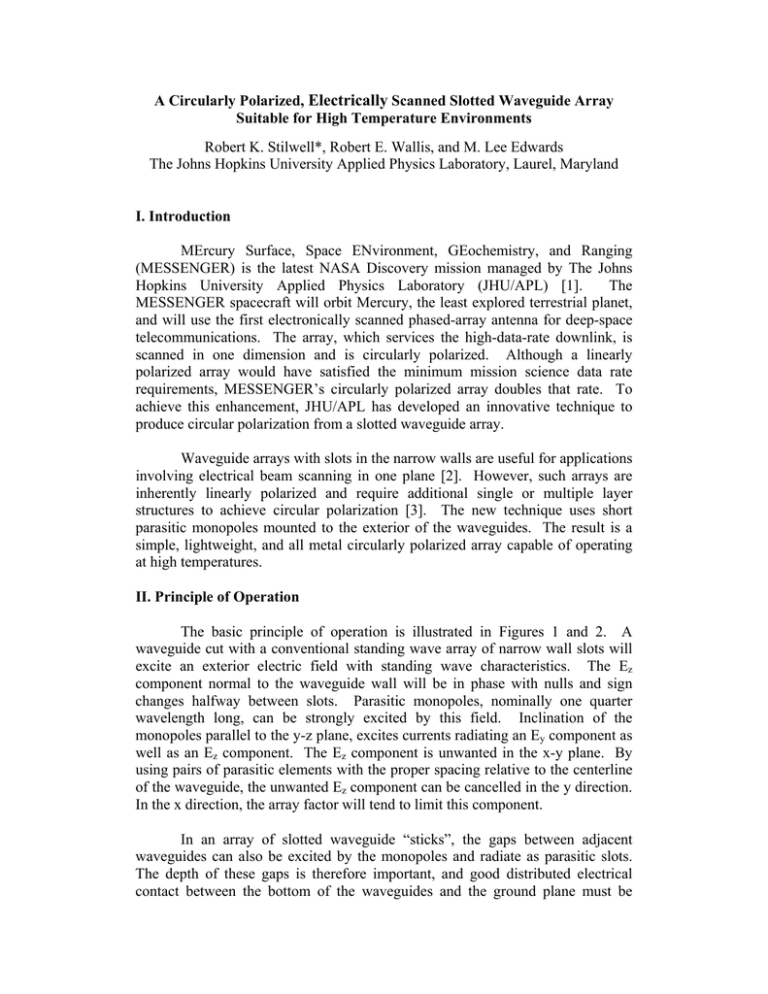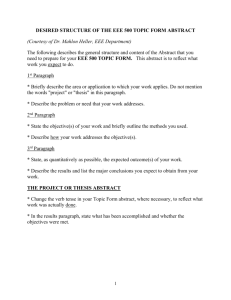Electrically
advertisement

A Circularly Polarized, Electrically Scanned Slotted Waveguide Array Suitable for High Temperature Environments Robert K. Stilwell*, Robert E. Wallis, and M. Lee Edwards The Johns Hopkins University Applied Physics Laboratory, Laurel, Maryland I. Introduction MErcury Surface, Space ENvironment, GEochemistry, and Ranging (MESSENGER) is the latest NASA Discovery mission managed by The Johns Hopkins University Applied Physics Laboratory (JHU/APL) [1]. The MESSENGER spacecraft will orbit Mercury, the least explored terrestrial planet, and will use the first electronically scanned phased-array antenna for deep-space telecommunications. The array, which services the high-data-rate downlink, is scanned in one dimension and is circularly polarized. Although a linearly polarized array would have satisfied the minimum mission science data rate requirements, MESSENGER’s circularly polarized array doubles that rate. To achieve this enhancement, JHU/APL has developed an innovative technique to produce circular polarization from a slotted waveguide array. Waveguide arrays with slots in the narrow walls are useful for applications involving electrical beam scanning in one plane [2]. However, such arrays are inherently linearly polarized and require additional single or multiple layer structures to achieve circular polarization [3]. The new technique uses short parasitic monopoles mounted to the exterior of the waveguides. The result is a simple, lightweight, and all metal circularly polarized array capable of operating at high temperatures. II. Principle of Operation The basic principle of operation is illustrated in Figures 1 and 2. A waveguide cut with a conventional standing wave array of narrow wall slots will excite an exterior electric field with standing wave characteristics. The Ez component normal to the waveguide wall will be in phase with nulls and sign changes halfway between slots. Parasitic monopoles, nominally one quarter wavelength long, can be strongly excited by this field. Inclination of the monopoles parallel to the y-z plane, excites currents radiating an Ey component as well as an Ez component. The Ez component is unwanted in the x-y plane. By using pairs of parasitic elements with the proper spacing relative to the centerline of the waveguide, the unwanted Ez component can be cancelled in the y direction. In the x direction, the array factor will tend to limit this component. In an array of slotted waveguide “sticks”, the gaps between adjacent waveguides can also be excited by the monopoles and radiate as parasitic slots. The depth of these gaps is therefore important, and good distributed electrical contact between the bottom of the waveguides and the ground plane must be established. For the end waveguide sticks in an array, “dummy” waveguides can be used to create gaps on both sides of the active sticks. Figure 2 shows an idealized model with an infinite ground plane in place. If the current on the parasitic monopoles is in phase with the electric field in the waveguide slots, the y component of the monopole current (Jm) together with its negative image (Jmi) will produce a radiated Ey field approximately 90° out-ofphase with the Ex field from the equivalent magnetic current of the waveguide slot (Ms) and its positive image (Msi). The currents on the ground plane near the base of a monopole are expected to be nearly in phase with the currents on the monopole. The gap between the waveguides acts like a reactive parallel plate transmission line stub, so the electric field across the gap should be 90° out-ofphase with the ground plane current. The radiated Ey field from the equivalent magnetic current system (Mg, Mgi) of the gap is therefore expected to be in phase with the Ey field from the monopole. To achieve circular polarization, the radiated fields contributed by the combination of the parasitic monopoles and gaps should be equal in magnitude as well as in phase quadrature to that of the slots. The location of the monopoles relative to the slots, the length and slant angle of the monopoles, and the depth of the gaps are all important in establishing this condition. The radiation admittance of the slots is changed by the parasitic elements, so their inclination relative to the waveguide axis must be adjusted to achieve a good input match. The resonant nature of the parasitic elements limits the bandwidth of their operation. However, for a reasonable length standing wave array, the bandwidth of the series feed remains the limiting factor. Other examples of the use of wire elements parasitically excited by slots to generate circular polarization include antennas designed for TV broadcast [4,5]. The techniques for planar arrays of narrow wall waveguide slots described in this paper have some new features. These include use of the standing wave nature of the near field and slot-like radiation from the gaps between adjacent sticks. III. The MESSENGER Mission and Antenna Due to the proximity to the Sun, the probe must remain behind a protective sunshade. The spacecraft can, however, be rotated around the Sunprobe line to point the antennas in one plane. The telecommunications system therefore uses a pair of antennas capable of scanning ±45º in the other plane to achieve full 4π steradian coverage [1]. The antennas are small and light weight, and have been qualified for an operating temperature range of –100 to +315°C. The antenna developed for MESSENGER uses standing wave arrays of narrow wall slots. There are eight radiating sticks of WR-90 waveguide, made from aluminum with 0.020 inch wall thickness. The sheet metal parasitic monopoles and waveguides are gold plated to allow attachment with very high temperature solder. Each stick has 26 slots, and is fed from the center to increase the impedance bandwidth. Adjustable short circuits at both ends are used for impedance tuning. The sticks are spaced at one half wavelength to allow wide angle scanning and are securely bolted to a ground plane. The gap depth is naturally obtained from the waveguide outer dimensions. A single dummy waveguide is mounted to either side of the eight active sticks. Each stick is fed with a solid state transmit module which includes a four-bit phase shifter for phase scanning. The flight antenna assembly is shown in Figure 3. The measured performance of the MESSENGER array is shown in Figures 4 and 5. Figure 4 shows the broadside gain and circularity as a function of frequency. The axial ratio is below 2 dB for well over a 1.2% bandwidth, similar to the impedance bandwidth of the individual sticks. Figure 5 shows the gain when the array was electrically scanned in 1° increments and measured at the intended scan angles. The gain of the array, referenced to the waveguide input has a broadside value of 28.0 dB corresponding to an aperture efficiency of 62%. The scan loss fits a (cosθ)n curve with n=2.5. The axial ratio remains below 2 dB for scan angles out to 40°. The performance of the circularly polarized array satisfies all mission requirements and provides twice the science data return over a linearly polarized array. IV. Conclusion A technique using parasitic monopoles has been developed which generates circular polarization directly from a planar array of narrow wall waveguide slots. Good scanning performance has been demonstrated with an array capable of operating under extreme temperature conditions. Acknowledgments This work was supported by the NASA Discovery Program under contract to the Johns Hopkins University Applied Physics Laboratory (NAS5-97271). References 1) 2) 3) 4) 5) Andrew G. Santo, et. al., “The MESSENGER mission to Mercury: spacecraft and mission design,” Planetary and Space Science 49, 1481-1500 (2001). Robert S. Elliot, “The Design of Waveguide-Fed Slot Arrays” Ch. 12 in Antenna Handbook, Y. T. Lo and S. W. Lee, eds., Van Nostrand Reinhold, New York, pp. 12-25 to 12-28 (1993). K. S. Min, J. Hirokawa, K. Sakurai, M. Ando, N. Goto, and Y. Hara, “A Circularly Polarized Waveguide Narrow-wall Slot Array using a Single Layer Polarization Converter,” 1996 IEEE AP-S International Symposium, Vol. 2, APsession 23, pp.1004-1007, Baltimore Maryland, U.S.A. (July 1996). McKinley R. Johns, “Circularly Polarized Antenna Using Slotted Cylinder and Conductive Rods,” U.S. Patent 4,129,871 (12 Dec 1978). John L. Schadler, “Variable Circular Polarization Antenna Having Parasitic ZShaped Dipole,” U.S. Patent 4,899,165 (6 Feb 1990). Figure 1. Array geometry Figure 2. Currents and fields Figure 3. The flight antenna for MESSENGER 5 28.0 4 27.8 3 27.6 2 27.4 1 27.2 0 8.40 8.42 8.44 8.46 8.48 8.50 Frequency (GHz) Gain (RHCP) Axial ratio Figure 4. Boresight gain and axial ratio variations with frequency 29 28 27 26 25 24 5 4 3 2 1 0 Axial Ratio (dB) 28.2 Gain (dBic) Scan Pattern for the Array Axial ratio (dB) Gain (dBic) Array Frequency Response -45 -30 -15 0 15 30 45 Scan angle (deg) Gain (RHCP) Axial ratio Figure 5. Gain and axial ratio variations with scan angle






